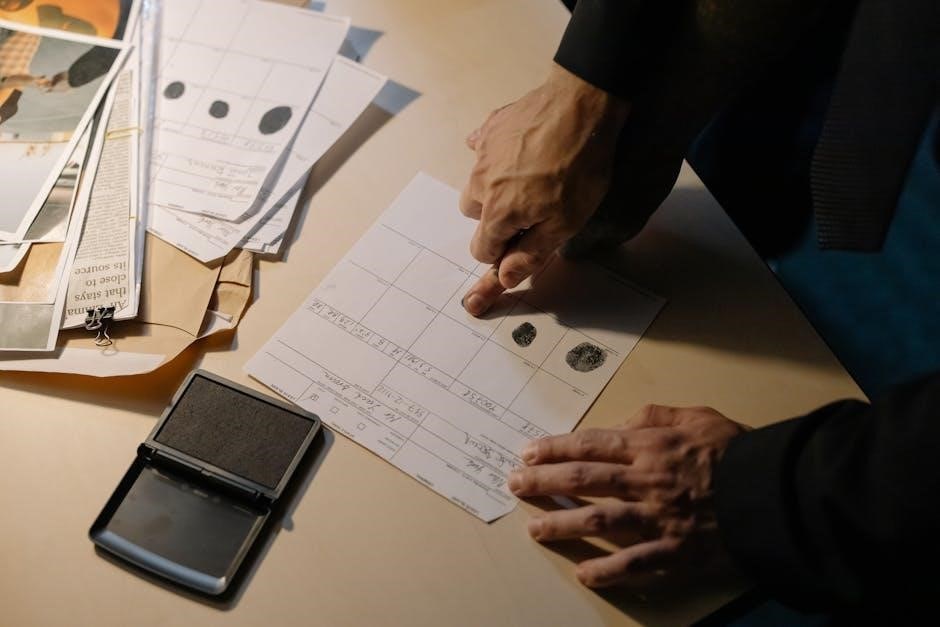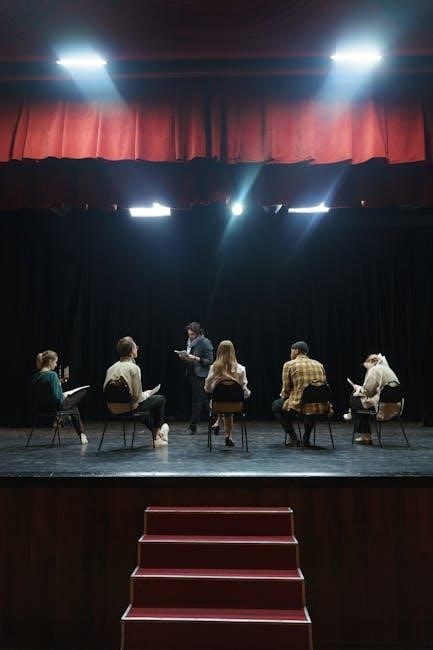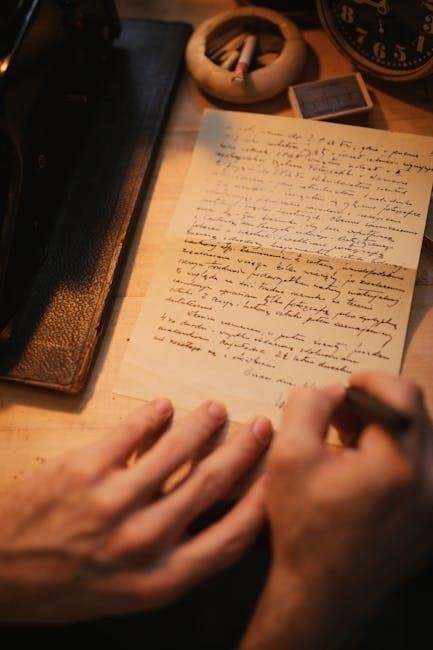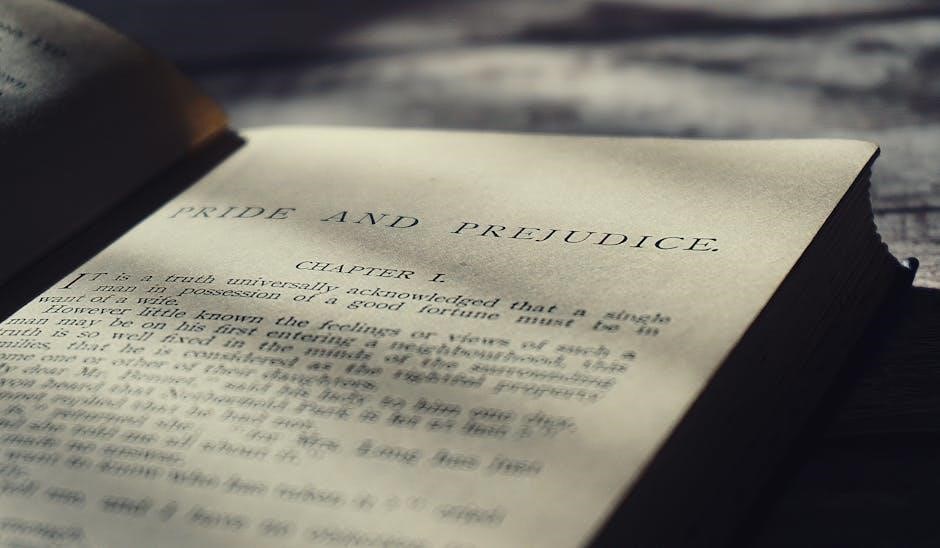The Fisher-Price Xylophone Song Book is a delightful resource designed to introduce toddlers and preschoolers to music through simple, color-coded notes and letter-based melodies. Perfect for beginners, it offers a fun and engaging way to learn musical basics, with a lightweight design that ensures safe and enjoyable play. Available as a free PDF, it’s easily accessible on tablets or in print, making music education accessible and enjoyable for young learners.
1.1 Overview of the Fisher-Price Xylophone Song Book
The Fisher-Price Xylophone Song Book is a charming, educational resource designed for toddlers and preschoolers to explore music. It features 23 letter-coded melodies, making it easy for beginners to play without prior musical knowledge. The book uses color-coded notes and character icons to guide young learners, ensuring a fun and engaging experience. Available as a free PDF, it can be accessed on tablets or printed for hands-on use. Its lightweight, age-appropriate design ensures safety and durability, while the simple format helps children develop musical skills through play.
1.2 Purpose and Target Audience
The Fisher-Price Xylophone Song Book is crafted to simplify music learning for toddlers and preschoolers, fostering creativity and confidence. Its primary purpose is to provide an accessible, enjoyable way for young children to engage with music. Designed for both children and adults with no prior musical experience, it serves as a tool for parents and educators to introduce musical concepts. The book’s target audience includes toddlers aged 1-3 years and preschoolers up to 5 years, making it an ideal resource for early childhood education and home use.
1.3 Importance of Music Education for Toddlers and Preschoolers
Music education plays a vital role in the cognitive and emotional development of toddlers and preschoolers. It enhances memory, language skills, and creativity while fostering self-expression. The Fisher-Price Xylophone Song Book leverages this by providing a simple, engaging method for young learners to explore music. By introducing basic musical concepts, it lays a foundation for future learning and appreciation. Music also aids in motor skill development and social interaction, making it an essential part of early childhood education and a valuable tool for parents and educators.
Features of the Fisher-Price Xylophone Song Book
The Fisher-Price Xylophone Song Book features color-coded notes, a letter-based system, and a lightweight, age-appropriate design, making it perfect for toddlers and preschoolers to learn music effortlessly.
2.1 Color-Coded Notes for Easy Learning
The Fisher-Price Xylophone Song Book features color-coded notes, designed to simplify learning for toddlers and preschoolers. Each note is represented by a specific color, making it easy for young learners to identify and play the correct notes. This visual system helps children develop cognitive skills and hand-eye coordination while fostering a love for music. The color coding also enhances memory retention, allowing beginners to follow melodies intuitively. This innovative approach ensures that even those without prior musical knowledge can enjoy playing their favorite tunes with confidence and accuracy.
2.2 Letter-Based System for Beginners
The Fisher-Price Xylophone Song Book incorporates a letter-based system, simplifying music learning for beginners. Each note is labeled with a letter, eliminating the need for traditional music reading skills. This approach makes it accessible for toddlers and preschoolers to identify and play notes correctly. The letter system aligns with the xylophone’s keys, guiding young learners to press the right notes effortlessly. It fosters cognitive development and creativity while introducing basic musical concepts. This intuitive method ensures that even those new to music can enjoy playing their favorite tunes with confidence and accuracy, making learning fun and engaging.
2.3 Lightweight and Age-Appropriate Design
The Fisher-Price Xylophone Song Book is designed with toddlers and preschoolers in mind, featuring a lightweight and age-appropriate format. Its compact size makes it easy for little hands to handle, while the durable pages withstand frequent use. The design ensures safety, avoiding heavy materials that could pose a risk to young children. This thoughtful construction allows kids to focus on learning and playing without discomfort or difficulty. The lightweight nature also makes it portable, enabling musical fun at home, in classrooms, or on the go, fostering an engaging and interactive learning experience for young minds.
How to Use the Fisher-Price Xylophone Song Book
Download the PDF, print, and laminate pages for durability. Use color-coded notes to guide children in matching notes to the xylophone, fostering an interactive learning experience.

3.1 Step-by-Step Guide for Parents and Caregivers
Download the Fisher-Price Xylophone Song Book PDF from a trusted source. 2. Print the pages and laminate them for durability. 3. Introduce the color-coded notes and letter-based system to your child. 4. Demonstrate how to match notes to the xylophone. 5. Encourage your child to follow along and experiment with melodies. 6. Use the included guide to teach basic techniques and rhythm. 7. Incorporate practice into daily routines for consistent learning. This method ensures a fun and educational experience for your little one.

3.2 Tips for Engaging Children in Musical Activities
Encourage children to explore the xylophone by demonstrating the color-coded notes and letter-based system. Make it interactive by singing along to the melodies. Praise their efforts to build confidence. Incorporate the Fisher-Price Xylophone Song Book into daily routines, such as before bedtime or during playtime. Use the PDF on tablets for a digital experience or print and laminate pages for hands-on learning. Encourage creativity by letting them experiment with different note combinations. Make it a family activity to foster bonding and shared enjoyment of music.
3.3 Best Practices for Printing and Laminating Pages
For optimal use, print the Fisher-Price Xylophone Song Book PDF on high-quality paper or cardstock for durability. Use a color printer to ensure the color-coded notes are vibrant and clear. Laminate each page using a thermal laminator to protect against spills and wear. Consider hole-punching the pages and binding them with a ring for easy access. Store laminated pages in a protective folder to maintain organization. Regularly clean laminated pages with a damp cloth to keep them in good condition for frequent use.

Benefits of the Fisher-Price Xylophone Song Book
The Fisher-Price Xylophone Song Book enhances cognitive development, improves motor skills, and fosters creativity in toddlers and preschoolers through engaging, color-coded musical activities, making learning fun and effective.
4.1 Cognitive Development Through Music
The Fisher-Price Xylophone Song Book promotes cognitive development by enhancing memory, pattern recognition, and problem-solving skills. The color-coded notes and letter-based system help children recognize patterns and sequences, fostering logical thinking. Matching notes to letters improves memory, while understanding rhythm and timing boosts overall cognitive abilities. These activities encourage critical thinking and creativity, laying a strong foundation for future academic skills. The engaging and interactive nature of the song book makes learning enjoyable, ensuring that children develop essential cognitive skills while having fun with music.
4.2 Motor Skill Improvement
The Fisher-Price Xylophone Song Book enhances motor skills by encouraging children to press keys in sequence, improving hand-eye coordination and dexterity. The lightweight design allows little hands to manage the instrument effortlessly, promoting fine motor control. Color-coded notes guide children to press the correct keys, strengthening finger precision and coordination. Regular practice of melodies helps develop muscle memory and rhythm, preparing children for more complex musical instruments in the future. This interactive learning tool makes motor skill development fun and engaging for toddlers and preschoolers.
4.3 Creativity and Confidence Building
The Fisher-Price Xylophone Song Book fosters creativity and confidence in children by allowing them to experiment with melodies and rhythms. The color-coded notes and letter-based system make it easy for toddlers to create their own tunes, encouraging self-expression. As they master simple songs, children develop a sense of accomplishment, boosting their confidence. The interactive nature of the song book also inspires imaginative play, helping children feel proud of their musical achievements and fostering a lifelong love for music and creative exploration.
Downloading the Fisher-Price Xylophone Song Book PDF
Download the free Fisher-Price Xylophone Song Book PDF, perfect for toddlers and preschoolers. Easy to access on tablets or print for a fun musical experience.
5.1 Where to Find the Free PDF Download
The Fisher-Price Xylophone Song Book PDF is available for free download on the official Fisher-Price website and other trusted online platforms. Parents and educators can easily access it by searching for “Fisher-Price Xylophone Song Book PDF” on their preferred search engine. The PDF is compatible with tablets and devices, allowing for convenient access. Once downloaded, it can be printed and laminated for durable use. This resource is a great way to introduce toddlers and preschoolers to music education in a fun and engaging manner.
5.2 How to Access the Song Book on Tablets and Devices
To access the Fisher-Price Xylophone Song Book on tablets and devices, simply download the PDF file from the official website or trusted sources; Once downloaded, open the file using a PDF viewer app, which is standard on most devices. The song book is compatible with both Android and iOS devices, ensuring easy access for all users. Parents and educators can store the PDF in their device’s library or cloud storage for quick retrieval. This digital format allows for portability and convenience, making it easy to engage children in musical activities anytime, anywhere.
5.3 Troubleshooting Common Download Issues
When downloading the Fisher-Price Xylophone Song Book PDF, common issues may arise, such as slow download speeds or corrupted files. Ensure a stable internet connection to prevent interruptions. If the file doesn’t open, check for compatibility with your device’s PDF viewer. Clearing your browser’s cache or restarting the download can often resolve problems. Additionally, verify that your device has sufficient storage space. If issues persist, try using a different browser or device. For further assistance, refer to the provider’s support page or contact their customer service team for help.
Songs and Melodies Included in the Song Book
The Fisher-Price Xylophone Song Book features 23 letter-coded melodies, including popular tunes, classic nursery rhymes, and original compositions designed to engage young learners and simplify music education.
6.1 Popular and Favorite Tunes for Children
The Fisher-Price Xylophone Song Book includes a collection of popular and beloved children’s songs, such as Twinkle, Twinkle, Little Star and Mary Had a Little Lamb. These familiar melodies are designed to captivate young learners, making music education fun and accessible. The color-coded notes and letter-based system simplify the learning process, allowing toddlers and preschoolers to play along effortlessly. The inclusion of these timeless tunes ensures that children can enjoy recognizable music while developing their musical skills. This feature makes the song book a delightful tool for early childhood music exploration and creativity.

6.2 Classic Nursery Rhymes and Lullabies
The Fisher-Price Xylophone Song Book features a charming selection of classic nursery rhymes and soothing lullabies, such as Humpty Dumpty and Rock-a-Bye Baby. These timeless tunes are perfect for introducing young children to the world of music. The color-coded notes and simple melodies make it easy for toddlers to follow along, fostering early musical development. The inclusion of lullabies also helps create a calming atmosphere, making the song book a versatile tool for both play and relaxation. This collection of beloved rhymes and lullabies ensures a delightful musical experience for little ones.
6.3 Original Compositions for Learning
The Fisher-Price Xylophone Song Book includes original compositions tailored for educational purposes, designed to make learning music fun and engaging. These unique pieces utilize the color-coded note system, helping beginners recognize patterns and develop musical skills. The compositions are crafted to be simple yet effective, encouraging creativity and confidence in young learners. They complement the classic nursery rhymes and popular tunes, offering a well-rounded musical experience. These original works are perfect for introducing toddlers and preschoolers to the joy of creating and playing their own music, fostering a lifelong love for musical exploration.

Additional Resources and Accessories
The Fisher-Price Xylophone Song Book is complemented by educational apps offering interactive music lessons, enhancing the learning experience with fun, engaging activities for young musicians.
7.1 Fisher-Price Xylophone Instrument
The Fisher-Price Xylophone Instrument is a durable, child-friendly tool designed for toddlers and preschoolers to explore music. Its lightweight and age-appropriate design ensures safe play, while the color-coded notes align perfectly with the songbook, making learning intuitive. The instrument’s simplicity encourages creativity and motor skill development, allowing children to experiment with sounds and rhythms. Paired with the songbook, it provides a comprehensive musical experience, fostering a love for music from an early age. Its compact size and sturdy construction make it ideal for both home and classroom use.
7.2 Compatible MIDI Files and Sheet Music
The Fisher-Price Xylophone Song Book is complemented by compatible MIDI files and sheet music, offering a versatile learning experience. These files can be downloaded for free and are designed to work seamlessly with the songbook. MIDI files provide audio playback, allowing children to hear the melodies, while sheet music supports visual learning. Compatible with tablets, computers, and digital instruments, these resources enhance the educational value of the songbook. They are perfect for parents and educators seeking to integrate music into daily activities, ensuring a comprehensive and engaging musical experience for young learners.
7.4 Educational Apps for Music Learning
Educational apps complement the Fisher-Price Xylophone Song Book by offering interactive music learning experiences. These apps feature rhythm games, note recognition exercises, and simple composing tools tailored for young learners. They often include audio clips of the songbook’s melodies, allowing children to hear and mimic the tunes. Many apps also provide step-by-step lessons and progress tracking, making music education fun and engaging. Compatible with tablets and smartphones, these apps extend the learning experience beyond the physical songbook, offering a modern and interactive way to explore music and creativity alongside the Fisher-Price Xylophone Song Book.

User Reviews and Feedback
Parents and educators praise the Fisher-Price Xylophone Song Book for its simplicity and effectiveness in teaching music to toddlers. Many highlight its engaging, easy-to-follow design, making it both educational and fun for young learners. The lightweight and age-appropriate format has received positive feedback, with users appreciating its portability and durability. Overall, it’s a well-loved resource for fostering creativity and confidence in children through music.
8.1 Parent Testimonials and Experiences
Parents have shared overwhelmingly positive experiences with the Fisher-Price Xylophone Song Book, praising its simplicity and effectiveness. Many highlight how the color-coded notes and letter-based system make it easy for their toddlers to grasp musical concepts. One parent noted, “It’s amazing how quickly my child picked up the melodies!” Others appreciate the lightweight design, calling it “perfect for little hands.” The song book’s ability to foster creativity and confidence has made it a favorite in many households, with parents encouraging others to try it for their young musicians.
8.2 Teacher Recommendations
Teachers highly recommend the Fisher-Price Xylophone Song Book for its educational value and ease of use in classroom settings. Many educators praise its alignment with early childhood music education goals, noting how it helps children develop rhythm and melody recognition. The color-coded system and letter-based approach are particularly commended for their ability to engage young learners. Teachers also appreciate the lightweight design and durability, making it ideal for group activities. Several have incorporated it into their curriculum, highlighting its effectiveness in fostering creativity and musical awareness among preschoolers.
8.3 Ratings and Overall Satisfaction
The Fisher-Price Xylophone Song Book has received overwhelmingly positive ratings from parents and educators, with many praising its simplicity and effectiveness. Users highlight its ease of use, engaging design, and the joy it brings to children while learning music. The color-coded notes and letter-based system are frequently commended for making musical education accessible to young learners. Overall satisfaction is high, with many considering it a valuable tool for fostering creativity and musical awareness in toddlers and preschoolers. Its free availability and versatility across devices further enhance its appeal.

The Role of the Fisher-Price Xylophone Song Book in Early Childhood Education
The Fisher-Price Xylophone Song Book plays a significant role in early childhood education by teaching music through color-coded notes and letters, fostering cognitive and motor skills development in toddlers.
9.1 Integration into Curriculum
The Fisher-Price Xylophone Song Book seamlessly integrates into early childhood education curricula, offering a playful approach to music learning. Its color-coded notes and letter-based system align with foundational musical concepts, making it an ideal supplement for classroom activities. Teachers can incorporate the song book into daily routines, using its simple melodies to teach rhythm, timing, and basic music theory. The lightweight design ensures it’s easy to handle in group settings, while its durability supports frequent use in educational environments. This resource enhances sensory and cognitive development, making it a valuable tool for educators aiming to foster creativity and musical awareness in young learners.
9.2 Enhancing Classroom Activities
The Fisher-Price Xylophone Song Book enhances classroom activities by providing engaging, interactive musical experiences for young students. Its color-coded notes and letter-based system make it easy for children to follow along, fostering group participation and collaboration. The lightweight design allows for seamless integration into classroom routines, while its accessibility on tablets or printed pages offers flexibility. Teachers can use the song book to teach rhythm, timing, and basic music theory through familiar tunes, making learning fun and interactive. This resource not only enriches musical education but also encourages creativity and teamwork among students.
9.3 Long-Term Benefits for Children
The Fisher-Price Xylophone Song Book offers long-term benefits for children by fostering a lifelong appreciation for music and enhancing cognitive development. Through its color-coded notes and letter-based system, it improves memory, concentration, and fine motor skills. The song book also nurtures creativity and confidence, encouraging children to explore their musical talents. By introducing basic music theory in a fun and accessible way, it lays a strong foundation for future musical interests and academic success. These skills and interests can positively impact a child’s personal and educational growth for years to come.
The Fisher-Price Xylophone Song Book is a wonderful tool for introducing children to music, offering a fun and educational experience that fosters creativity and confidence. With its easy-to-use design and engaging melodies, it provides long-term benefits for cognitive and motor skill development. Perfect for toddlers and preschoolers, this song book is a great way to spark a lifelong love for music. Download the free PDF today and watch your child grow into a confident young musician!
10.1 Summary of Key Points

The Fisher-Price Xylophone Song Book is a vibrant, educational tool designed for toddlers and preschoolers, offering 23 letter-coded melodies for easy learning. With color-coded notes and a lightweight design, it promotes cognitive development, motor skills, and creativity. The free PDF is accessible on tablets or in print, making it ideal for both home and classroom use. Its simplicity and engaging format encourage musical exploration, fostering confidence and a lifelong love for music. Perfect for parents and educators, this song book is a must-have for early childhood music education.
10.2 Encouragement to Try the Song Book
Discover the joy of music with the Fisher-Price Xylophone Song Book, a perfect tool for introducing toddlers and preschoolers to the world of melody. Its color-coded notes and letter-based system make learning fun and accessible. The free PDF is easy to download and use, whether on a tablet or in print. This song book is a delightful way to foster creativity, confidence, and a love for music in young minds. Give it a try and watch your child’s musical journey begin with excitement and ease!

10.3 Future Updates and Expansions
The Fisher-Price Xylophone Song Book is expected to evolve with new features and content. Future updates may include additional melodies, interactive digital versions, and expanded educational resources. Developers aim to enhance accessibility, possibly adding audio guides for visually impaired children. More advanced musical concepts could be introduced for older learners. The song book may also integrate with other Fisher-Price instruments, offering a comprehensive musical experience. Regular feedback from users will guide these improvements, ensuring the song book remains a valuable tool for early music education and fun for years to come.










































































